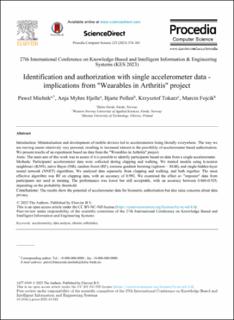| dc.contributor.author | Mielnik, Pawel | |
| dc.contributor.author | Hjelle, Anja Myhre | |
| dc.contributor.author | Pollen, Bjarte | |
| dc.contributor.author | Tokarz, Krzysztof | |
| dc.contributor.author | Fojcik, Marcin Andrzej | |
| dc.date.accessioned | 2023-12-18T09:26:32Z | |
| dc.date.available | 2023-12-18T09:26:32Z | |
| dc.date.created | 2023-10-28T15:39:05Z | |
| dc.date.issued | 2023 | |
| dc.identifier.citation | Procedia Computer Science. 2023, 225 374-383. | en_US |
| dc.identifier.issn | 1877-0509 | |
| dc.identifier.uri | https://hdl.handle.net/11250/3107968 | |
| dc.description.abstract | Introduction: Miniaturisation and development of mobile devices led to accelerometers being literally everywhere. The way we are moving seems intuitively very personal, resulting in increased interest in the possibility of accelerometer-based authorisation. We present results of an experiment based on data from the "Wearables in Arthritis" project. Aims: The main aim of this work was to assess if it is possible to identify participants based on data from a single accelerometer. Methods: Participants' accelerometer data were collected during clapping and walking. We trained models using k-nearest neighbours (KNN), naïve Bayes (NB), random forest (RF), extreme gradient boosting (xgboost – XGB), and single-hidden-layer neural network (NNET) algorithms. We analysed data separately from clapping and walking, and both together. The most effective algorithm was RF on clapping data, with an accuracy of 0.992. We examined the effect av "imposter" data from participants not used in training. The performance was lower but still acceptable, with an accuracy between 0.860-0.929, depending on the probability threshold. Conclusions: The results show the potential of accelerometer data for biometric authorisation but also raise concerns about data privacy. | en_US |
| dc.language.iso | eng | en_US |
| dc.publisher | Elsevier | en_US |
| dc.rights | Attribution-NonCommercial-NoDerivatives 4.0 Internasjonal | * |
| dc.rights.uri | http://creativecommons.org/licenses/by-nc-nd/4.0/deed.no | * |
| dc.title | Identification and authorization with single accelerometer data - implications from "Wearables in Arthritis" project | en_US |
| dc.type | Peer reviewed | en_US |
| dc.type | Journal article | en_US |
| dc.description.version | publishedVersion | en_US |
| dc.rights.holder | © 2023 The Authors | en_US |
| dc.source.pagenumber | 374-383 | en_US |
| dc.source.volume | 225 | en_US |
| dc.source.journal | Procedia Computer Science | en_US |
| dc.identifier.doi | 10.1016/j.procs.2023.10.022 | |
| dc.identifier.cristin | 2189514 | |
| cristin.ispublished | true | |
| cristin.fulltext | original | |
| cristin.qualitycode | 1 | |

